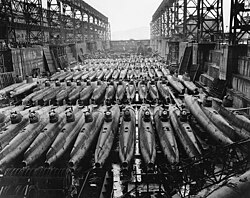Kōryū (submarine)
|
Koryu in dry dock in Kure (October 1945)
|
||||||||||||||
|
||||||||||||||
|
||||||||||||||
|
||||||||||||||
|
||||||||||||||
The submarine class type D ( Japanese. 甲 標的 丁 型 [潜水 艦] , kō-hyōteki tei-gata [sensuikan] , "target A, type D [-U-boat]") or Kōryū ( 蛟 竜 / 蛟龍 , " [water] dragon ", also known in the figurative sense as "misunderstood genius"), was a series-produced class of miniature submarines of the Imperial Japanese Navy . It emerged from the Type C submarine class developed in 1943 , but was no longer used before the end of the war.
Development history
The Type D (actually tei from kō-otsu-hei-tei numbering system ) consisted essentially of a mixture of types B and C. He united all hitherto accumulated experience, but could not take all the weaknesses of the predecessors. The long charging time of the batteries during operation with the aid of the diesel engines of 18 hours was regarded as unsatisfactory, so that the Japanese naval command could not use the type D for use in the extended coastal area. His mission remained in the closer coastal apron or, brought by carrier ships to the operational area, the open sea. After completion in mid-1944, the test ship was given the designation Ha 77 and showed good results in subsequent test drives. After minor modifications, however, series production could not begin until July 1945 due to the worsening war situation in the Pacific War .
The changes after the test drives primarily concerned the shortening of the long battery charging time of 18 hours, which thanks to a 150 hp diesel engine could be reduced to eight hours. The common room and headquarters were made larger to accommodate five people. The range for overwater travel with 4.5 t of equipment was 1000 nm at 8 kn or underwater 320 nm at 6 kn. The assembly of the boat, which had a diving depth of 100 meters, was carried out using five pre-assembled sections that were put together. The primary armament consisted of two 45-cm torpedoes of the Type 98 in the bow . The relocation of the boats to operational areas that were beyond their reach should be carried out using the specially built LST I type express transporter . Once there, the boats, which had previously been moored on the deck, could be brought into the water by sliding rails.
At the end of the war in September 1945, the following Japanese shipyards were busy building the Kōryū :
- Naval shipyard in Kure : 100 boats under construction, 60 completed
- Naval shipyard in Maizuru : 50 boats under construction, 14 completed
- Yokosuka naval shipyard : 50 boats under construction, 6 completed
- Harima shipyard in Aioi 39 boats under construction
- Hitachi shipyard on Mukaijima (in today's Onomichi ): 30 boats under construction, 2 completed
- Kawasaki shipyard in Kobe : 47 boats under construction
- Mitsubishi shipyard in Kobe: 17 boats under construction
- Mitsubishi shipyard in Nagasaki : 60 boats under construction, 3 completed
- Mitsubishi shipyard in Yokohama : 32 boats under construction
- Nikita Iron Works: 12 boats under construction
- Mitsui in Tamano : 30 boats under construction, 30 completed
115 boats were completed, and a further 496 boats were in the final stages. Originally, 570 boats had been planned by September 1945. After that, production should be around 180 boats per month. Due to the lack of torpedoes towards the end of the war, an unknown number of Koryu were provided with TNT explosive charges between 585 and 600 kg in the bow area, which were supposed to function as self-sacrifice boats. The boats were no longer used in war.
literature
- Harald Fock: Naval small weapons. Manned torpedoes, small submarines, small speedboats, explosives yesterday - today - tomorrow. Nikol, Hamburg 1996, ISBN 3-930656-34-5 , p. 48.
